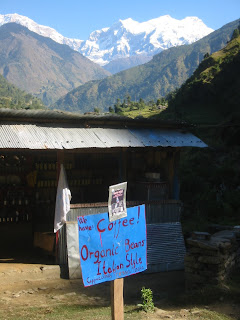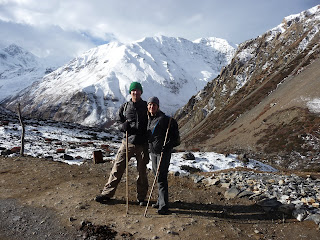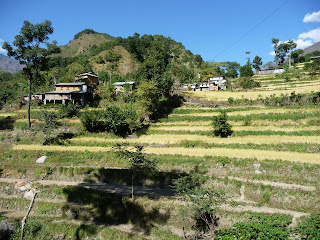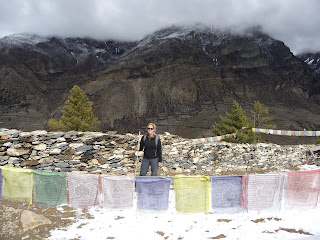 Before the hiking began, we put our Team Opps Himalaya Stimulus Plan into action. Code-named NEPAL (Nepali Employment Provided by American Laziness), it entailed hiring a guide and porter to help us along the way. This increased our costs considerably, but took lots of the unknown out of the journey, freed us from logistical concerns and heavy backpacks, and provided jobs for some hard-working locals. Our guide quickly earned the nickname "Silent Drew" for his tendency towards minimal chatter. Over the course of our weeks together, enormous cajoling, questioning, prodding, and joking loosened him up and we considered him a friend by the end. Our porter was an Equal Employment Opportunity poster child. Since we don't discriminate on the basis of age, we had a 55-year old grandfather from low-lying Southern Nepal carrying our gear while we lollygagged along with daypacks. Most of the time, we felt somewhere between guilty and sheepish about the arrangement, but kept coming back to the fact that he had done the trek many times and knew what he signed up for. Our porter, Ram, also evolved into a lovable character as the sojourn progressed and Ben is honored to have a constant reminder of him everytime he smells his backpack.
Before the hiking began, we put our Team Opps Himalaya Stimulus Plan into action. Code-named NEPAL (Nepali Employment Provided by American Laziness), it entailed hiring a guide and porter to help us along the way. This increased our costs considerably, but took lots of the unknown out of the journey, freed us from logistical concerns and heavy backpacks, and provided jobs for some hard-working locals. Our guide quickly earned the nickname "Silent Drew" for his tendency towards minimal chatter. Over the course of our weeks together, enormous cajoling, questioning, prodding, and joking loosened him up and we considered him a friend by the end. Our porter was an Equal Employment Opportunity poster child. Since we don't discriminate on the basis of age, we had a 55-year old grandfather from low-lying Southern Nepal carrying our gear while we lollygagged along with daypacks. Most of the time, we felt somewhere between guilty and sheepish about the arrangement, but kept coming back to the fact that he had done the trek many times and knew what he signed up for. Our porter, Ram, also evolved into a lovable character as the sojourn progressed and Ben is honored to have a constant reminder of him everytime he smells his backpack.The terrain of the first half of the circuit was a slow and steady climb from low-lying foothills to the world's highest pass. Over ten days, we inched our way from summer to winter and lush jungle to desolate snowfields. Climatically, it was like walking from the equator to the polar ice cap in just over a week. We started our journey in steamy jungle foothills, which the residents have tamed with marching escalators of terraces clinging to the steep mountainsides. Most of the terraces contain rice paddies at the lower elevations, where water is plentiful, and these mountains enjoy a verdant green shag carpet, the product of the summer monsoons. As we climbed higher, the scenary grew drier and more desolate. Millet fields replaced rice paddies and the banana trees gave way to pines, which eventually dwindled and petered out. As we neared the high pass, we hiked through falling snow for three days and the barren surroundings took on a unblemished sheen of blazing white. Luckily in the lowlands, we grabbed some bamboo hiking sticks from the forest, as these would prove quite necessary on the slippery ascent.
Throughout the climb, we watched the local people change as well. At lower elevations, the faces of the villagers bear a close resemblance to those of North India. Likewise, the predominant religion in the low-lying areas is Hindu. This is definitely not the place to ask for a double cheeseburger. As we worked our way north, the Tibetan influence increased visibly. Shrines to Ganesh and Vishnu faded away, to be replaced by ubiquitous Buddhist prayer flags and wheels. These religious icons send prayers to heaven with every gust of wind or turn of the wheel, assisting the populace with their quest for Nirvana. Local faces also grew increasingly Tibetan at higher elevations, a stark reminder of the natural dividing line that these gigantic peaks provide.
The wildlife we encountered along the way tended toward the invertebrate. There must be a Himalayan law of nature that these beasts meet rather generous minimum size requirements. We tangled with spiders, mantids, millipedes, and moths, all of which were at least as long as our index fingers. With this in mind, we are thankful we did not visit during the monsoon, which is known as "leech season." Our fauna highlights were sightings of monkeys and blue sheep, though most of the animals we saw were livestock. This was a novelty at the beginning, but we quickly became immune to the crowing roosters and bellowing cows. Community Sustained Agriculture, organic produce, and free range livestock may be the latest fad in the US these days, but most of Nepal knows no alternative. The villages we passed through rely on their goats, oxen, and chickens for food, clothing, fuel, fertilizer, and horsepower, the same way most of the First World did before the Industrial Revolution. Our favorite farm animal was the shaggy yak, whose dung became a trusted source of valuable heat in the treeless and frigid highlands.
The extreme inaccessibility of the hamlets we passed through insures that even with a steady trickle of foreign backpackers infringing, the traditional way of life does not change rapidly. Any product that cannot be grown or raised in a particular village must be brought in on the back of a mule or human. This has slowed the influx of "modern" goods. From a sightseer's perspective, this is a wonderful thing, allowing us to see villages in something close to their original cultural state. It is less clear if this benefits the locals, who are struggling with the tug-of-war between the allure of consumerism and the preservation of their own culture.
Our excitement along the trail came from some predictable, but also many unexpected, directions. Certainly the towering peaks and cultural learnings provided the expected highlights. Often it was the more commonplace occurrences that we had not anticipated that got our hearts racing. The narrow, winding trail often clung to steep cliff sides and we had innumerable river crossings on swinging Indiana Jones-style bridges, with white water surging underneath. We saw copious graffiti bearing the Soviet hammer and sickle, a constant reminder of the Maoist element, whose on-going quest for a Communist state has boiled over into civil war at times in the last decade. We were stopped on the trail at times by armed soldiers while construction crews used dynamite to blast into the cliffs around us, in a controversial bid to build a road. Minutes after the explosions ceased (and well before the dust cleared), we were allowed to proceed, picking our way through the jagged stone remains and splintered fuses.
 Outside of these unforeseen pulse-quickeners, we quickly settled into a satisfying routine on the trail. After the day's hike, typically lasting 3-6 hours, we settled into our lodge for the day. A large part of the appeal of this circuit is that one can avoid carrying and using camping gear and instead stay in local villages. The inns are called "tea houses", and consist of small plywood-walled rooms for sleeping, a common room for dining, and pit toilet. Lodging conditions have modernized considerably over the last few decades - it was not long ago that hikers slept on piles of straw on the the floor of a family's house. Once we checked in and ate lunch, we generally explored the town and often did some side hikes to higher elevations to assist with the acclimation. We also burned considerable time playing cards, as evidenced by the two decks that we wore out on the trek. With a handful of new games at our disposal, we will have no problem entertaining ourselves next time we get stranded somewhere. One of our most memorable nights was spent in a tiny local "cinema", where "Into Thin Air" was projected onto a hanging bed sheet while we huddled around the stove on yak skins and munched popcorn. Aside from the fact the the film ends with death and disaster in the Himalaya (which hit a bit too close to home for skittish trekkers), it was the prefect way to spend a cold, snowy evening.
Outside of these unforeseen pulse-quickeners, we quickly settled into a satisfying routine on the trail. After the day's hike, typically lasting 3-6 hours, we settled into our lodge for the day. A large part of the appeal of this circuit is that one can avoid carrying and using camping gear and instead stay in local villages. The inns are called "tea houses", and consist of small plywood-walled rooms for sleeping, a common room for dining, and pit toilet. Lodging conditions have modernized considerably over the last few decades - it was not long ago that hikers slept on piles of straw on the the floor of a family's house. Once we checked in and ate lunch, we generally explored the town and often did some side hikes to higher elevations to assist with the acclimation. We also burned considerable time playing cards, as evidenced by the two decks that we wore out on the trek. With a handful of new games at our disposal, we will have no problem entertaining ourselves next time we get stranded somewhere. One of our most memorable nights was spent in a tiny local "cinema", where "Into Thin Air" was projected onto a hanging bed sheet while we huddled around the stove on yak skins and munched popcorn. Aside from the fact the the film ends with death and disaster in the Himalaya (which hit a bit too close to home for skittish trekkers), it was the prefect way to spend a cold, snowy evening.In our next installment, we will detail our assault on the high pass. Enjoy the pictures, and see you soon!












































okay...now i'm totally jealous.
ReplyDeleteOnce again, great stories, details pictures and of course video. Did you get to see Grace? We hung out with her when she was in Austin a few weeks ago and were talking about your thanksgiving visit. Cant wait to see and learn more from your adventures. Sounds like you are really taking advantage of everything. Hope to see you both soon! The AppeLester's miss you both!
ReplyDeleteHey Guys! It's BookFair at Gullett! My 'cousin' is here and Ms. Gooch is traveling the world this week! I have told everyone I think Ms. Gooch is in Tibet tracking down Mrs. Opps - they are totally loving that! With the theme being "reading around the world" your name has come up quite a bit! I am looking forward to a long break! I bought a townhouse! More on that another day! hugs and kisses! k
ReplyDelete